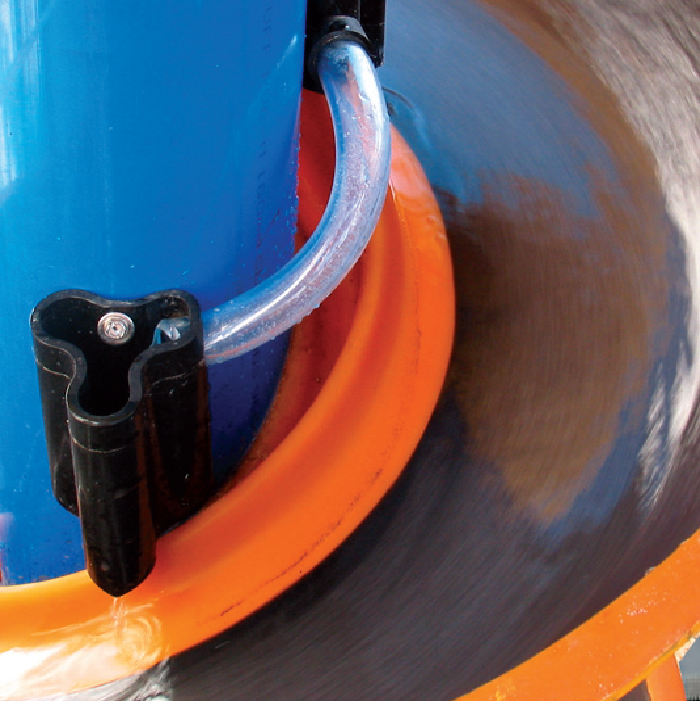A Complete Range of Spirals for Minerals Concentration
As the most simple gravity separation technology, and arguably the most efficient, spiral concentrators have long played an important role in minerals processing. The spiral concentrator is one of the most effective, low-cost devices for the gravity beneficiation of ores. Manufactured from lightweight, corrosion and abrasion resistant materials, spirals require a minimum of maintenance and upkeep. Spiral concentrators offer a relatively simple unit operation that translates to low capital and operating cost. This, coupled with reagent free processing, provides a necessary environmentally desirable process.
Outotec Spiral Concentrators are all wear-resistant polyurethane/fiberglass construction helices. Each spiral is supplied complete with detachable feed and product discharge boxes of solid cast polyurethane. The product box will simultaneously collect product middlings and tails, from each spiral start.
Principle of Separation
Spiral separation is based on the specific gravity difference present in a feed mineral suite. When fed a dilute pulp mixture of minerals of different specific gravities, the lighter minerals are more readily suspended by the water and attain relatively high tangential velocities so that they climb toward the outer rim of the spiral trough.
At the same time, the heavier non-suspended grains migrate by saltation along the lowest part of the spiral cross section. Saltation is defined as non-linear motion that is a combination of rolling and bouncing.
In some models, slurry is selectively directed with adjustable product splitters into product discharge outlet ports down the helix. Other models utilize protuberances to agitate flowing slurry and help release trapped minerals for improved recovery. Lastly, some models use the addition of wash water at various points down the column providing more efficient washing of the concentrate. The specific model required for precise separation is dependent on the needs of a specific application.
Like most concentrating devices that utilize physical separation principles, the spiral works best on a reasonably closely-sized feed; but, in some cases, the unit does have some tolerance for wide size ranges. In general, a coarse size limit would be around 20 mesh (Tyler Standard), or 1mm, and a fine limited around 325 mesh (45 microns). For best performance, feed should be relatively free of slimes (-325 mesh), since a high slime content may act like a “heavy medium” and decrease the effective differences in specific gravity between the minerals to be separated. As a rule of thumb, -325 mesh slime in excess of 5% by weight of the spiral feed may reduce efficiency; and desliming, as a pre-concentrating step should be evaluated. If slime is in excess of 10% by weight, desliming prior to spiral concentration will almost certainly result in improved spiral performance.
A specific gravity difference of at least 1 is required between light and heavy particles to make a successful gravity separation.
Low grade spiral in operation
Medium grade spiral in operation
High grade spiral in operation
Spiral Operation
Slurry enters the spiral through a feed box and is introduced on to the spiral surface. Once on the spiral surface, the mineral grains settle and sort according to size, shape and specific gravity.
Generally, the particles with the lowest specific gravity are carried with the water towards the outside wall of the spiral. The density of the tailings stream, therefore, becomes more diluted as it contains the bulk of the liquid.
The product discharge boxes are provided with one to two heavy-duty splitters for separating up to two products into concentrate and tails. Product boxes are manufactured of solid-cast polyurethane and are designed to collect product from each spiral start.
Spiral Selection
Wash water spiral concentrators
Wash water spirals require the addition of water at various points down the spiral and therefore provide a “washing” of the concentrate, i.e., transporting away light gangue from the concentrate band.
The design of the Outotec wash water spiral, and especially the wash water system, was developed to meet the needs of modern ore producers. The patented open wash water cup minimizes the possibility of plugging while providing variable flow and point control at the spiral trough. The amount of wash water and its distribution down the spiral trough can be adjusted to meet operating requirements. Point control minimizes the total water requirement by efficiently directing the water into the flowing pulp at the most effective angle.
Wash waterless spiral concentrators
This type of spiral is used in most applications, particularly for concentrating low-grade ores. The only water required is added with the solids prior to introducing feed onto the spiral. Concentrates are removed either at the bottom directly into the product box or at several intermediate take-off points down the spiral.
Coal/Mica Spiral Spiral Concentrators
Larger diameter units than the mineral-spiral series, these spirals are designed to take advantage of the particle shape differences. Take-off splitters at different points down the helix give this spiral a high capacity to remove refuse or siliceous contaminants from the coal or the mica.






